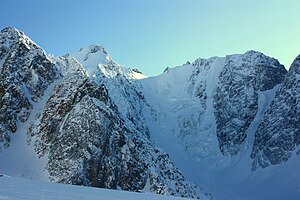The Cherskii–Kolyma mountain tundra ecoregion (WWF ID: PA1103) is an ecoregion that covers the higher elevations of the Chersky Range and the Kolyma Mountains, the only large mountain range in northern Russia. It is in the Palearctic realm, and tundra biome. It has an area of 556,589 square kilometres (214,900 sq mi).[1] [2]
| Ecoregion: Cherskii-Kolyma mountain tundra | |
|---|---|
 | |
 Ecoregion territory (in purple) | |
| Ecology | |
| Realm | Palearctic |
| Biome | Tundra |
| Geography | |
| Area | 556,589 km2 (214,900 sq mi) |
| Countries | Russia |
| Coordinates | 65°45′N 143°45′E / 65.75°N 143.75°E |
Location and description
editThe ecoregion encompasses terrain above 800 meters in the Chersky Range and Kolyma Mountains, in a mosaic of territory stretching 2,000 km from the Lena River in the west to the eastern edge of the Kolyma Mountains, and approximately 1,000 km from the Okhotsk Sea in the south to the coastal plain of the Arctic Sea in the north. The highest peaks reach 3,000 meters at Peak Pobeda.
Climate
editMost of the region has a Subarctic climate - very cold (Koppen classification Dfd). This climate is characterized by long, cold winters and short, cool summers with no month averaging over 22 °C (72 °F), and only one to three months in which the mean temperature rises above 10 °C (50 °F). Mean precipitation is about 237 mm/year. The mean temperature at the center of the ecoregion is −46.8 °C (−52.2 °F) in January, and 10.6 °C (51.1 °F) in July.[3]
Flora and fauna
editOnly hardy species can survive year around at altitude in this ecoregion. A few stands of larch may reach up to 1,000 meters, above that to about 1,900 meters might be found sub-alpine dwarf pine, followed by a thin zone of alpine tundra to 2,200 meters, and no plants above 2,200 meters.[4]
Protections
editThere is one significant nationally protected area that reaches into this ecoregion, the Magadan Nature Reserve, on the southern edge of the ecoregion along the sea of Okhotsk.
See also
editReferences
edit- ^ "Cherskii-Kolyma mountain tundra". GlobalSpecies.org. Archived from the original on December 19, 2018. Retrieved November 20, 2018.
- ^ "Cherskii-Kolyma mountain tundra". World Wildlife Federation. Retrieved November 20, 2018.
- ^ "Climate Data for Latitude 65.75 Longitude 143.75". GlobalSpecies.org. Archived from the original on December 16, 2018. Retrieved December 14, 2018.
- ^ Pavel V. Krestov. "Forest Vegetation of Easternmost Russia". CiteSeerX 10.1.1.624.5490.